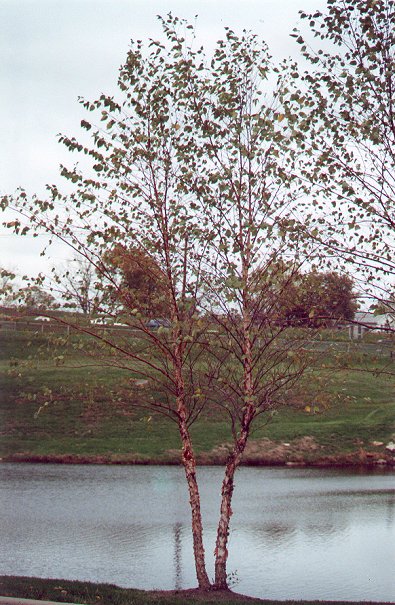Betula nigra L.
River Birch

Native
CC = 4
CW = -3
MOC = 59
© DETenaglia
Betula nigra L.River Birch | |
 |
Native CC = 4 CW = -3 MOC = 59 |
© DETenaglia |
|
Family - Betulaceae Habit - Trees, 10-15 m tall. Stems - Bark peeling in thin, papery sheets brown to reddish brown. Young growth not sticky or resinous. Twigs 1-2 mm thick, dark purplish brown, initially cobwebby-hairy, but glabrous or nearly so at maturity, the buds sessile, with 2 or 3 scales.
Leaves - Alternate, simple, petiolate. Petioles 7-14 mm long. Leaf blades 3.5-14.0 cm long, 2-10 cm wide, triangular-ovate, the undersurface glaucous, sparsely or moderately soft-hairy, smooth or felty to the touch, the tip narrowed or short-tapered to a sharp point, the base broadly rounded to nearly truncate, the margins finely toothed and sometimes also shallowly lobed, the lateral veins 6-10 on each side of the midrib and usually unbranched.
Inflorescence - Inflorescences of separate staminate and pistillate catkins. Flowers - Actinomorphic, imperfect. Corollas absent. Staminate flowers with 2 or 3 stamens, with a reduced, nonfunctional pistil sometimes present. Pistillate flowers with calyces rudimentary or absent; stamens and staminodes absent; ovary inferior (but often appearing naked in the absence of perianth), with 2 locules toward the base but often appearing 1-locular toward the tip, the placentation axile. Styles 2 (sometimes united basally), each with a linear stigmatic region toward the tip.
Fruits - Clusters of 30-70 conelike samaras, these 2-3 mm long, smooth, brown, discoid. Flowering - April - May. Habitat - Alluvial ground along streams, gravel beds. Also cultivated. Origin - Native to U.S. Lookalikes - Leaves are similar to those of many other species. Bark is distinctive. Other info. - This species can be found throughout Missouri, and also throughout the eastern half of the U.S. It is the only representative of its genus in the state. The tree likes wet ground, though in cultivation it can grow just about anywhere. It is a pioneer plant along sandy river banks and typically starts forest succession in these areas. Photographs taken off Prairie View Rd., Platte County, MO., and in Brown Summit, NC., 2-7-03. |